Introduction:
Imagine a world where anyone, regardless of their background or circumstances, can unlock their full potential and achieve their educational goals. This reality could be closer than you think, thanks to a reassessment of funding distribution in adult education programs. But why is this reassessment happening, and what impact could it have?
Understanding the Need for Change:

Currently, many adult education programs struggle with inadequate funding, limiting their ability to offer essential resources and support to diverse learners. This creates a barrier to progress for countless individuals seeking to upskill, retrain, or pursue their educational aspirations. The reassessment of funding aims to address this issue by creating a more equitable and efficient allocation of resources.
Exploring Adult Education:
- Increased funding for programs serving high-demand job sectors: This will equip learners with the skills needed to succeed in today’s dynamic economy.
- Targeted support for underserved communities: Ensuring equitable access to resources for all, regardless of background or ethnicity.
- Investment in technology and resources: Modernizing programs to meet the evolving needs of learners and educators.
Opening the Textbook on a New Chapter:

Imagine yourself yearning to learn a new skill, upgrade your qualifications, or perhaps finally earn that high school diploma. Yet, the doors of opportunity seem locked, held shut by the rusty hinges of inadequate funding in adult education programs. But wait! A wave of change is on the horizon, with a critical reassessment of funding distribution holding the key to unlocking these doors and empowering countless individuals to pursue their educational dreams. Let’s delve deeper into this exciting prospect, understanding the need for change, exploring proposed solutions, and ultimately, igniting a call to action.
The Imperative for Change: A Glimpse into the Unmet Needs:
The current state of adult education paints a sobering picture. Programs are often starved for resources, struggling to provide effective support and instruction to a diverse range of learners. This translates to limited course offerings, outdated technology, and overworked instructors – a far cry from the dynamic and supportive environment needed to foster successful learning. The consequences are profound, impacting individuals from all walks of life:
- Alia, a single mother: Dreams of starting a bakery but lacks the culinary skills and business knowledge to make it a reality.
- Carlos, a factory worker: Facing automation fears, desperately needs to upskill to remain competitive in the job market.
- Maria, an immigrant: Yearns to earn her GED but cannot afford traditional schooling.
These are just a few snapshots of the countless individuals grappling with the limitations of underfunded adult education programs. Each story reflects a lost opportunity, a potential snuffed out due to lack of resources.
Turning the Page: Proposed Solutions for a Brighter Future:

Thankfully, this narrative is not set in stone. The reassessment of funding distribution offers a beacon of hope, with several proposals aiming to transform the adult education landscape:
- Targeted Funding for High-Demand Sectors: Imagine resources being directed towards programs that equip learners with the skills sought after in today’s dynamic job market, from coding and data analysis to renewable energy and healthcare. This ensures graduates are workforce-ready, contributing to economic growth and individual prosperity.
- Bridging the Digital Divide: Technology plays a crucial role in modern learning. Increased funding would allow programs to invest in interactive tools, online platforms, and accessible devices, fostering a more engaging and effective learning experience for all.
- Empowering Educators: Let’s not forget the dedicated instructors who are the cornerstone of adult education. Increased funding can translate into smaller class sizes, professional development opportunities, and competitive salaries, ultimately attracting and retaining talented educators who can deliver high-quality instruction.
- Equity-Based Resource Allocation: Recognizing the diverse needs of adult learners, funding should be distributed in a way that prioritizes underserved communities, ensuring programs are accessible and affordable for all, regardless of socioeconomic background or ethnicity.
Benefits Beyond the Pages: Investing in a Better Future:

The positive impact of a well-funded adult education system ripples outwards, touching individuals, communities, and society as a whole:
- Individuals: Imagine Alia mastering pastry-making, Carlos acquiring the skills to land a new job, and Maria confidently earning her GED. Each story represents a life transformed, empowered by the knowledge and skills gained through accessible and effective adult education.
- Communities: Strong communities thrive on educated individuals. With increased access to educational opportunities, individuals contribute more meaningfully to their communities, fostering economic growth, civic engagement, and overall well-being.
- Society: Imagine a nation brimming with a skilled and adaptable workforce, readily embracing new technologies and contributing to innovation. This is the reality that a robust adult education system can help usher in, benefiting everyone.
Turning the Final Page: Taking Action for a Brighter Future:

The reassessment of funding distribution is not merely a bureaucratic exercise; it’s an opportunity to create a brighter future for countless individuals and society as a whole. But turning this potential into reality requires action. Here’s how you can be a part of the change:
- Write to your local policymakers: Let your voice be heard! Express your support for increased funding and advocate for specific program improvements that resonate with your community’s needs.
- Share your story: The power of personal narrative is undeniable. Share your own experience with adult education or how it has impacted someone you know. This personal touch humanizes the issue and strengthens the call to action.
- Join advocacy groups: Collaboration is key. Connect with organizations working to ensure equitable access to quality adult education. By joining forces, you can amplify your voice and achieve greater impact.
Let’s move beyond the outdated narrative of limited opportunity in adult education.
By advocating for fair funding distribution, we can unleash the full potential of programs that empower individuals, strengthen communities, and pave the way for a brighter future for all. Together, let




